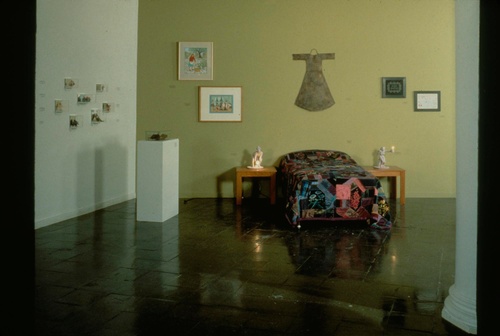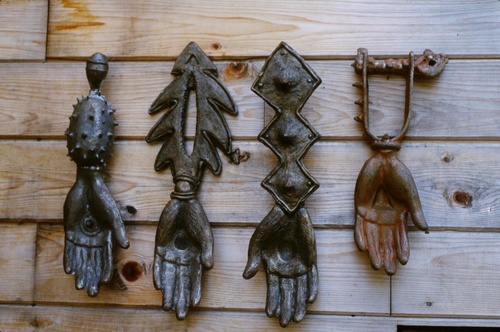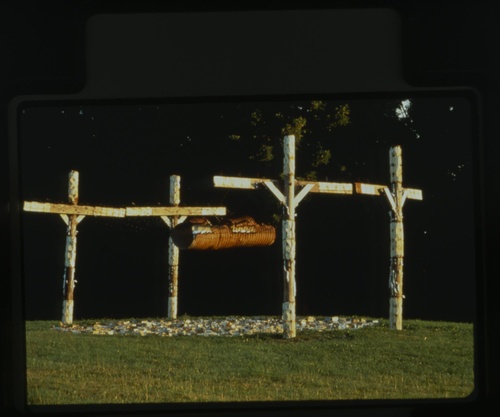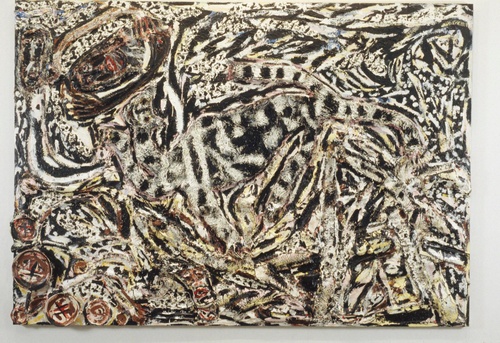Nari Ward & Thornton Dial
ATLAS: Winter/Spring 2019
Nari Ward in Conversation with Thornton Dial, in his studio, 1993
Filmed by: France Morin
Location: Bessemer, Alabama
Around the time that Nari Ward was installing his work Carpet Angel in the New Museum’s New Work space at 583 Broadway, curator France Morin approached him to see if he would be interested in assisting with another upcoming exhibition. A solo show focusing on Thornton Dial, then known as a “folk artist,” was scheduled to open in November 1993, held jointly at the New Museum and the American Folk Art Museum in New York.1 Morin asked Ward to accompany New Museum staff on a trip down to Dial’s farm and studio in Bessemer, AL, to conduct a videotaped interview.
Ward agreed, later saying that Dial—who also worked with found material in dialogue with African-American experience—was particularly inspiring because his practice existed largely outside the mainstream of white-cube galleries and major metropolitan institutional spaces. In the video above, made public for the first time as part of the New Museum’s Digital Archive, Ward and Dial speak about Dial’s sense of survival, his imagery and motifs, and the use of everyday materials in the artistic process.
The heavily encrusted, built-up surfaces of Dial’s paintings are the result of foraging, reclamation, and reorganization: the artist affixes found materials like scrap metal, bits of rope, tree limbs, discarded clothing, and handfuls of sand to the canvas surface and then further works them into the representational plane by applying paint. For Dial, the repurposed objects he chooses contain histories of labor and transformation that existed long before he came along to reclaim them. In a series of interviews with art historian and collector William Arnett for the Souls Grown Deep Foundation, Dial noted:
“I seen a lot of stuff peoples were making for the farm. And I watched blacksmiths. I have paid close attention to the blacksmith works. When I start making something, I gather up the pieces I want to work with. I only want materials that have been used by people, the works of the United States, that have did people some good but once they got the service out of them they throwed them away. So l pick it up and make something new out of it… . Everything I pick up be something that done did somebody some good in their lifetime. So I’m picking up on their spirit. It’s going to make you think about the work, the labor, what good they have did. When you make things beautiful out of another person’s ideas, it make the world more beautiful.” 2
In the conversation between Ward and Dial, this idea of the creative process carrying on the legacy of an object or material forges a space of shared understanding for the two artists:
Nari Ward: How do you choose what goes into [your] paintings?
Thornton Dial: Oh, just like you say—you go out and you find your stuff and you bring it back and you put it together. And then you wait with your picture. You wait with your picture until you get it right … . Everything I put in the picture was somebody else’s idea before it was mine. Before I picked it up, and brought it back to life.
Nari Ward: It’s so funny hearing you say all this, because that’s exactly the same sort of approach that I do.
This connection proved especially meaningful to Ward as a form of permission to explore themes that he had previously been anxious about letting into his work. In a panel discussion associated with Dial’s New Museum and Museum of American Folk Art exhibition, “Image of the Tiger: The Way Life Travels,” which took place in late winter 1993, Ward reflected: “The materials that he uses and how he transforms it is interesting to me and it’s similar—the knotting, the meticulous tying down, and the wrapping—these are all important components of how we both work, or how we invest energy in our work… . That’s the magic that I shoot for in my work—the idea of transforming, of one thing becoming two things becoming three. And when that happens to the viewer, when they see the whole and then they realize the parts, I think there’s something that happens that transcends just the materials.” 3
Concepts of energetic “magic” contained in specific materials allowed Ward to speak more frankly about the elements of spirituality and religion in his own work. Early site-specific installations like Praise I and Praise II (both 1991)—crucifix forms and deep holes dug into the earth and latticed with leather and tin—or his MFA thesis work, Marketplace Altar (1992), with its ironing board predella and sanctuary of hanging feathers and dried plantains, deliberately points to spaces of worship and shapes of the sacred. Yet he remained wary of the way in which explorations of these forms and materials could shunt him too easily into closed-off categories, particularly those that were othering: “Jamaican,” “spiritual,” “immigrant,” and so on. 4
In his closing remarks for the panel discussion, Ward affirmed the significance of speaking to Dial (and to artist-musician Lonnie Holley, whom he met on the same trip) about the ways in which they openly integrated magic, spiritualism, and religion into their artistic expressions:
“In coming back from Bessemer, Alabama, I had a real good feeling, and not just from meeting Mr Dial and Lonnie Holley. I had a real good feeling that something I was missing, I was exposed to. In the past when I’ve talked about my work, it’s always been the formal things and the process—the formal aspects and the materials. And when I met Lonnie Holley and Thornton Dial, these people and the way they talked about their work, they were expressing things that I was afraid to say because they weren’t supposedly ‘important contemporary art issues.’ Things about spiritualism, things about religion and how I grew up as a Baptist and how that affected my view of the world, and my view of materials and materials that were part of other people’s lives. So it allowed me to feel free about speaking about these things and feeling that I belonged … and it was a feeling of being thankful that I had gone.” 5
Maggie Mustard, Ph.D. Marcia Tucker Senior Research Fellow, New Museum of Contemporary Art Published March 25, 2019.
-
By this time (the early 1990s), certain curators and critics had begun to question the underlying assumption inherent to the labeling of artists like Dial as “folk” or “outsider” artists. In the panel discussion “Image of the Tiger: The Way Life Travels,” held on December 9, 1993, moderator Patricia Spears Jones remarked that Dial “is not ‘folk’ because of what he makes, but because of who he is. Is the who he is important? Can he be separated from community? Can these canvases be isolated from recent social history?” The guest curator of the American Folk Art Museum, Thomas McEvilley, reflected on being invited to organize the show, noting that “the problem had precisely to do with the categorization implied by the Folk Art Museum’s title. [Dial’s] work didn’t just come by itself. It came pre-equipped with a set of interpretative categories that essentially dismissed it from the kind of serious and open attention I felt it deserved. These dismissive or exclusionary categories are naive art, folk art, outsider art, primitive art, and so on. These terms involve pejorative connotations that we all know how to instantly read. They all suggest inadequate development, as in the cultural efforts of children, and invite neglect and dismissal. So one couldn’t just go directly to the work, I saw. Immediately one had to confront these categories and the various theoretical constructions that have upheld them for so long. You had to create a route to the work, or clear a way to it.” Image of the Tiger: The Way Life Travels, New Museum, New York, December 9, 1993. The New Museum further explored the questions of how and why certain forms of cultural production are labeled “outsider” or “folk” art with the exhibition “A Labor of Love,” organized by Marcia Tucker (January 20 – April 14, 1996).
, January 20 – April 14 1996A Labor of Love

-
“Thornton Dial,” Souls Grown Deep Foundation, accessed February 28, 2019, http://www.soulsgrowndeep.org/artist/thornton-dial. The language above reflects the Souls Grown Deep Foundation’s preference to transcribe interviews with verbatim vernacular grammar. William Arnett founded the Souls Grown Deep Foundation with the goal of preserving and promoting African-American artwork from the American South. In the late 1980s, Arnett began collecting the work of Thornton Dial and similar artists, helping to raise their national profile. However, his career has also been marked by controversy, particularly by accusations that he has unfairly profited from the work of African-American artists. For a more in-depth look at the history of Arnett and Souls Grown Deep, see Geoff Edgers, “Bill Arnett won’t shut up. His stunning African American art collection is why,” Washington Post, March 9, 2017, https://www.washingtonpost.com/graphics/lifestyle/bill-arnett-african-american-art-collection
-
“Image of the Tiger: The Way Life Travels,” public program, December 9, 1993. Featuring guest curator Thomas McEvilley, moderator Patricia Spear Jones, Lowery Stokes Sims, Nari Ward, and Judith McWillie.
, December 9 1993Image of the Tiger: The Way Life Travels

-
See Diana Nawi, “Being in the World,” in Nari Ward: Sun Splashed (New York: DelMonico Books/Prestel, 2015), 17.
-
“Image of the Tiger: The Way Life Travels,” public program, December 9, 1993. Featuring guest curator Thomas McEvilley, moderator Patricia Spear Jones, Lowery Stokes Sims, Nari Ward, and Judith McWillie.
, December 9 1993Image of the Tiger: The Way Life Travels





